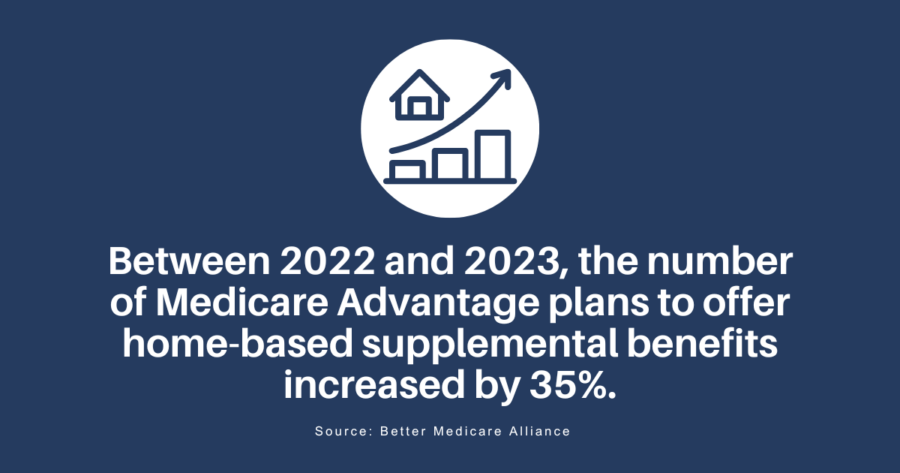
Today, the average Medicare beneficiary can choose from 43 Medicare Advantage (MA) plans. As care continues to move into the home, MA is on track to become a major payer for non-medical home-based benefits. In fact, over the last year, there was a 35 percent increase in MA plans offering home-based supplemental benefits.
“The payer industry is acknowledging what home care providers have long known,” said Dina CEO Ashish V. Shah in Managed Healthcare Executive. “It is possible to reduce costs and improve the quality of care by offering wraparound non-medical supplemental benefits such as in-home support, transportation, durable medical equipment, and nutrition services.”
What are Medicare Advantage Supplemental Benefits?
MA plans have long been able to offer “primarily health-related” supplemental benefits not covered by fee-for-service Medicare, such as vision and dental coverage. These types of supplemental benefits have been an important differentiator among MA offerings, allowing people to identify plans that offer benefits and services that meet their needs. Regulatory changes have expanded what MA plans can offer as supplemental benefits to include non-medical services such as transportation, meal delivery and home modification.
But it’s not enough to offer rich supplemental benefits. Health plans also need to manage timely delivery of services to ensure their members are happy with the experience.
As health plans confront the logistical challenge of coordinating networks of new services, many are turning to digital solutions to streamline processes and improve the member experience. According to McKinsey, developing the right product and network design is a great start to getting members into a plan, but a significant investment in raising consumer awareness and optimizing the distribution strategy is also required. Here are six steps to improve service delivery to members:
1. Evaluate your Benefits Portfolio
First, take a critical look at your current portfolio. Are there opportunities to differentiate your organization by offering new home-centered services that address social determinant needs or support people with chronic conditions?
2. Use Technology to Activate Service Providers
Next, use benefits and care coordination technology to activate your partners on a shared digital platform. By digitizing the coordination process, you’ll gain real-time visibility into capacity and availability, and reduce the time required to connect members with the right services at the right time.
3. Empower Service Coordinators
The teams that are coordinating services need the resources and tools to keep provider information current. This can include up-to-date information on provider specialties, hours of operation, languages spoken, and more. With this information available and organized, service coordinators can expedite the benefit coordination and delivery process.
4. Make it Easy
Service coordinators and in-home service partners should be able to easily engage and collaborate, and the process should be designed to create a great experience for members. This can include jointly setting performance goals around member care, encouraging partners to validate outcomes with data, and using shared technology to facilitate communication.
5. Evaluate Service Delivery
Leverage data to determine if partners are meeting commitments on member satisfaction and service delivery. By evaluating service delivery, you can identify areas for improvement, take actions to address them, and, ultimately, improve the member experience.
6. Educate Members
Lastly, it’s important to educate members about available benefits and keep them connected to the process to determine satisfaction or unmet needs.
Powering Medicare Advantage Supplemental Benefits with Technology
Medicare Advantage economics is impacted by Star ratings, the CMS quality assessment program. Every year, CMS assigns Star ratings to MA plans to indicate their quality relative to other plans. Plans awarded four or more Stars earn a 5% bonus on CMS payment benchmarks, as well as higher rebates to use toward richer supplemental benefits for members. Beginning in 2023, member experience metrics will quadruple in value, determining 57% of overall Star ratings.
McKinsey estimates that MA plans received around $12.2 billion in Stars-related payments in 2020, while leaving around $2.9 billion on the table. In addition, Stars ratings also impact a Medicare Advantage plan’s member growth and retention, as the ratings serve as a differentiator for consumers choosing a plan.
Investing in technology to manage and coordinate home-based supplemental services is essential for improving connectivity and enhancing the overall member experience. These six steps will help organizations begin their own digital transformation and improve the way they coordinate and deliver care to their members. When done right, this can lead to more healthy days at home, higher member satisfaction and, ultimately, higher Star ratings and rates of retention.





